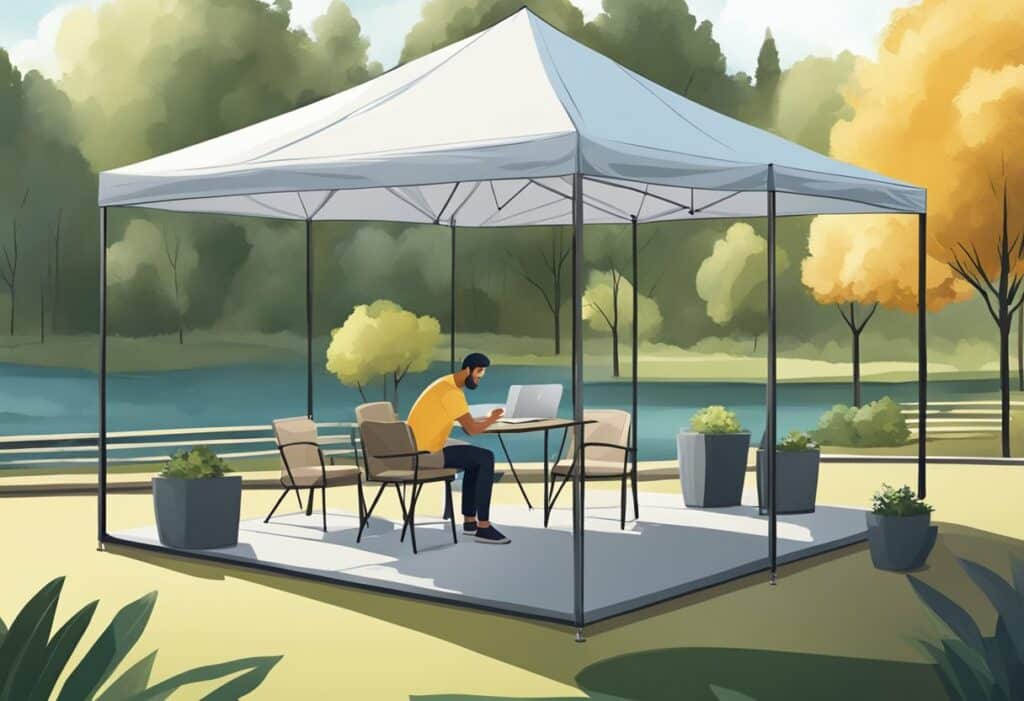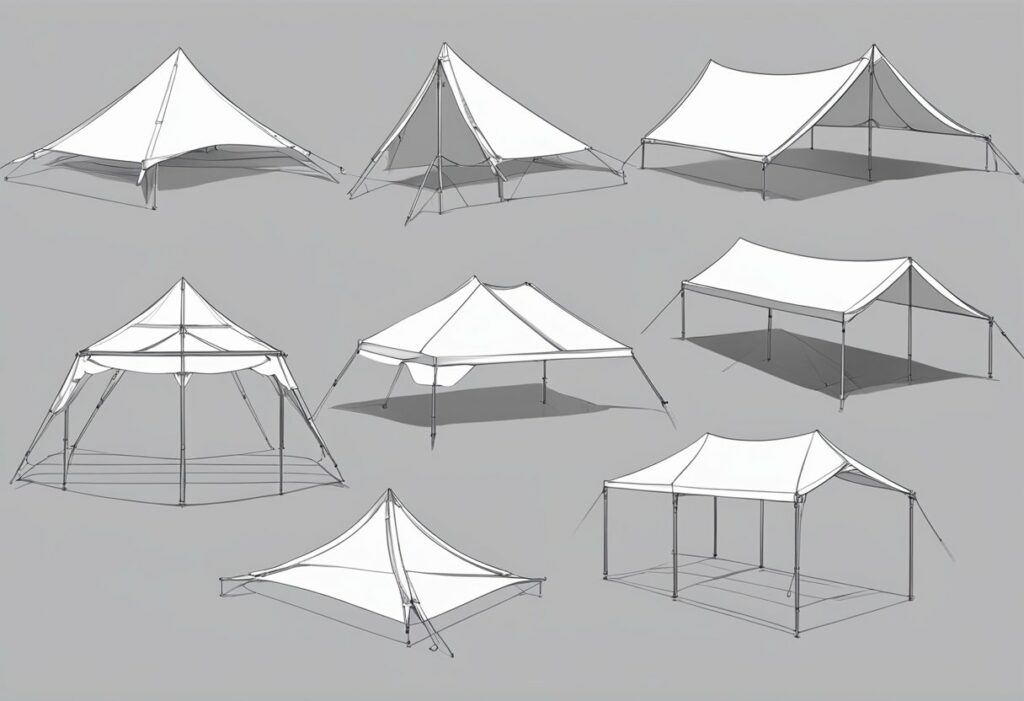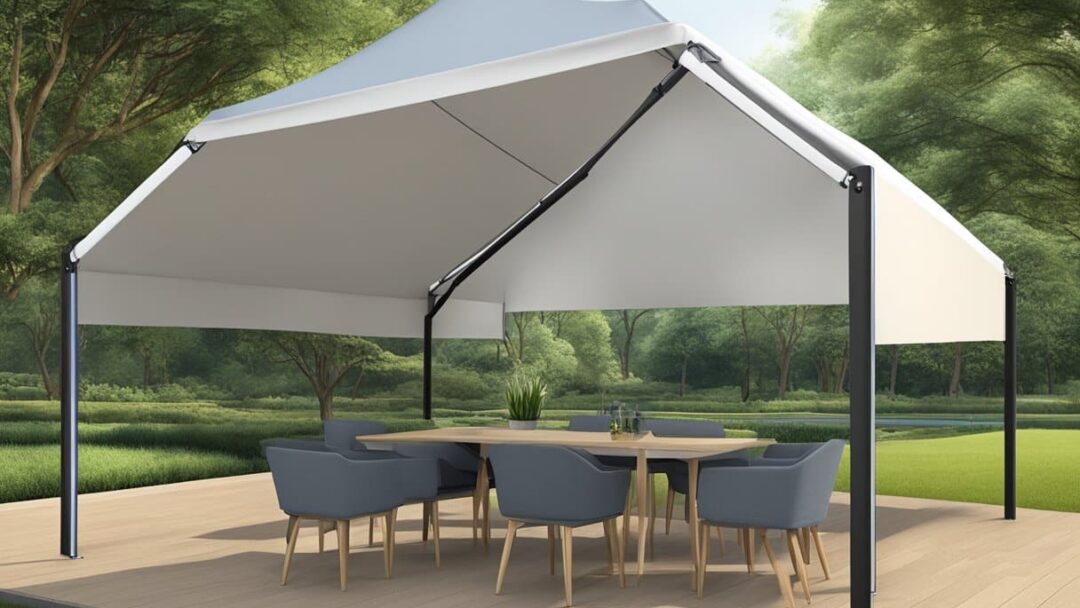Putting up a canopy tent can be an essential skill for hosting outdoor events, providing shelter at a market, or enjoying a day at the beach. A canopy tent offers a convenient way to protect guests and goods from the elements. Knowing how to erect one quickly and correctly can save time and prevent mishaps. By following a few simple steps and understanding the basics, anyone can set up a canopy tent effectively.
Choosing an appropriate location is the first crucial step; it ensures stability and maximizes the utility of the tent. Once a flat, clear area is selected, the actual setup process involves unfolding the frame, attaching the canopy top, and securing the structure. Regular maintenance coupled with proper handling further extends the life of the tent while ensuring user safety. Disassembling the tent correctly is just as important as the setup process, making sure that the canopy tent will be in good condition for its next use.
Key Takeaways
- Canopy tents provide versatile outdoor shelter.
- Proper setup and disassembly extend the tent’s life.
- Maintenance and correct usage ensure safety and stability.
Understanding Canopy Tents
When choosing a canopy tent, one must consider the different types available, the various components that make it functional, and the materials used for durability and protection against the elements.
Types of Canopy Tents
Canopy tents vary widely in design and purpose. Some are built for casual use at the beach or park, offering shade from the sun, while others are constructed for more heavy-duty applications, like large-scale outdoor events which may also need to withstand rain. Pop-up canopies are known for their ease of setup and portability, whereas frame tents and pole tents cater to more substantial and longer-term needs.
Components and Parts
The structural integrity of a canopy tent depends on its components. Typically, a canopy comprises a frame, usually made of either steel or aluminum, the roof material which rests atop the frame, and the anchoring mechanism to secure the tent to the ground. These anchor points might include stakes or weights. Most canopy tents also come with a carrying case for transport.
Material and Fabric Considerations
The fabric used in canopy tents is critical for determining its effectiveness and longevity. Durability is often provided by polyester or vinyl materials, which offer UV protection to reduce sun damage. A high-quality canopy should feature a waterproof and mildew resistant fabric to ensure that it remains functional and presentable over time, regardless of weather conditions.
Selecting the Right Location
When setting up a canopy tent, the right location is crucial for stability and functionality. This choice can significantly impact the success of the event being hosted under the canopy.
Assessing Terrain
Choosing a level surface for a canopy tent is essential to prevent it from toppling over. Even if an individual is skilled in setting up the structure, a canopy positioned on uneven terrain can fall, resulting in potential damage. They should look for solid ground; grassy areas are preferable. When one has to set up on concrete or asphalt, they must ensure that the canopy has robust weighted anchors since traditional stakes will not penetrate these surfaces.
Considering Weather Conditions
The weather plays a crucial role in the choice of location. One must take into account the direction of sun exposure to maximize shade throughout the day, especially for garden canopy events. Additionally, they should account for wind patterns to avoid areas that are prone to gusts, which could destabilize the tent. In case of rain, make sure there are no low points around that might lead to water accumulation near or under the canopy.
Importance of Space and Size
Space requirements primarily depend on the event‘s scale and the canopy tent’s size. The selected location should comfortably accommodate the full footprint of the canopy with extra space for guests to move around freely. It’s also essential to ensure that there aren’t any obstructions like low-hanging branches or fixed structures that could interfere with the canopy’s framework or fabric.

Setting Up Your Canopy Tent
Setting up a canopy tent involves several key steps: preparing the area, assembling the framework, attaching the top fabric, and ensuring everything is secure. These actions require attention to detail, following the instructions, and proper handling of the components.
Preparation Steps
Before beginning the setup process, one should choose a level area and clear it of any debris. It is crucial to lay out all parts of the canopy tent such as the frame, tent stakes, ropes, and fabric. Reviewing the instruction manual thoroughly helps anticipate each step.
Assembling the Frame
Assemble the frame by connecting the poles and canopy legs. Each joint typically locks in with a click or a snap. Ensure all brackets and screws are tightly fastened. If assistance is available, one person can hold the frame in place while another connects the pieces.
Attaching the Fabric Top
Once the frame is stabilized, it’s time to attach the fabric top. Starting from one end, drape the fabric over the frame and secure it by attaching any built-in hooks or velcro straps to the frame. Ensure the fabric is evenly spread over the structure without any folds or creases.
Securing the Canopy Tent
Finally, securing the tent is vital for stability. Use ground stakes and ropes to anchor the tent. In windy conditions, adding weights to the base of the tent legs is advisable. Guy lines should be taut and angled correctly to give the canopy added resistance against the elements.
Anchoring and Stabilization
Anchoring your canopy tent is crucial for stability and safety. Proper techniques prevent the structure from becoming a hazard in windy conditions. It’s imperative to employ secure tie-downs and use the right weights to ensure your shelter remains firmly in place.
Tie-Downs and Stakes
Tie-downs, such as ropes or cord, are essential for securing your canopy to the ground. Stakes should be driven into the soil at a 45-degree angle away from the tent. Velcro straps can also be used to attach guy lines to the canopy frame, providing additional stability. It’s important to:
- Fasten each rope securely to tent corners.
- Ensure stakes penetrate deeply for a firm hold.
Using Weights and Sandbags
In settings where stakes cannot be used, such as on concrete, employing weights and sandbags is effective. These should be placed around each leg of the canopy to maintain a stable structure. Adequate weights prevent lifting in high wind conditions. One must:
- Evenly distribute weight at each corner.
- Use heavy enough weights to counteract wind force.
Reinforcement Techniques
To further reinforce your canopy, adjust the height of the tent to its lowest setting during high winds, reducing the risk of it catching the wind. Velcro or other fastening materials can be used to secure any loose fabric. For optimal stability, consider these methods:
- Double-check points of tension for firm fastening.
- Employ additional velcro straps around the frame at multiple points.
Maintenance and Handling
Proper maintenance and handling of a canopy tent ensure its longevity and functionality. This includes regular cleaning, meticulous storage, and prompt repairs with the appropriate replacement parts when necessary.
Cleaning and Storage
To maintain the fabric of a canopy tent, it should be regularly cleaned to prevent the buildup of dirt and to deter the growth of mildew. Use a mixture of mild soap and water for the cleaning process, then rinse with a garden hose to remove soap residue. The fabric must be completely dry before storage to prevent mildew formation. When storing, choose a cool, dry space and avoid placing heavy items on top that could cause damage to the tent fabric.
Repair and Replacement
Routine inspections of the canopy tent’s fabric and frame are vital for identifying areas that may require repair or replacement parts. For any rips or tears in the fabric, a repair kit designed for the specific material should be used. For structural integrity, inspect the joints and hardware during takedown to ensure they are functional and replace any parts that show signs of wear or damage. Regular maintenance activities like these will help in avoiding unexpected malfunctions during future use.
Safety Tips
When setting up a canopy tent, safety should be the top priority. Proper precautions can ensure that both the tent and its occupants remain secure in various conditions.
Weather Precautions
Before erecting a canopy tent, one should consult the latest weather forecasts. If high winds or severe weather are predicted, it might be safer to postpone the event or secure the tent using specialized stakes and weights. For example, securely anchoring a tent can prevent it from becoming a hazard in unexpected wind gusts. The allincanopies.com emphasizes checking with local authorities for regulations that may influence how a canopy should be secured in certain weather conditions.
It’s also critical to monitor for rapidly changing weather, as many canopies are not designed to withstand extreme conditions such as heavy snowfall. The stability of the tent in various weather conditions is paramount, and in some cases, it is recommended to take down the tent altogether to ensure safety.
Fire Safety
Canopy tents often involve a risk of fire, especially if they are used in conjunction with cooking equipment or open flames. To minimize risk, ensure that fire safety measures like having fire extinguishers on hand are in place. Tents should be made of fire-resistant materials whenever possible, and a canopy should never be set up near open flames or electrical units. One should always keep fireworks and other sources of ignition at a safe distance to prevent potential fire hazards. Guidance provided by Promotional Design Group includes the supervision of an adult when using a canopy, which is an essential aspect of fire safety, especially if minors are present.
Disassembling and Storage
Proper disassembly and storage are crucial to maintain the longevity of a canopy tent. This section outlines the steps to safely take down and store the various parts and components of the structure.
Takedown Process
The takedown process involves reversing the assembly steps with careful attention to avoid damage to the frame and tarp. They should disconnect the clips and fastenings with care, then gently remove the tarp to prevent tearing. Folding each part methodically as per the instructions helps to ensure that the tent can be easily reassembled next time.
- Preparation: Before disassembling, they should check for any damage or debris.
- Removal of the Tarp: Carefully detach the tarp from the frame.
- Frame Dismantling: Gradually collapse the frame, starting from the top and moving downwards.
- Parts Separation: Segregate the tubes, connectors, and other structural components.
Storing Components
For storage, it is essential that the components are dry to prevent mold and rust. They must store the parts in a cool, dry place away from direct sunlight. Each piece should be organized and placed in such a way that it’s easy to identify and access when needed for future use.
- Before Storage: Ensure all parts are clean and completely dry.
- Tarp Storage: Fold the tarp neatly, avoiding sharp folds that might cause creases or cracks.
- Components Storage: Store poles and connectors in their original bags or boxes, if possible. Utilize clear labeling to ease future assembly.
- Clips and Fastenings: Keep small pieces like clips in a separate, marked container to prevent loss.
Troubleshooting Common Issues
When erecting a canopy tent, one may encounter a few common setbacks. A systematic approach to troubleshooting can ensure the canopy is set up safely and efficiently.
Canopy Instability
Canopy tents should remain stable and balanced to withstand elements such as wind. If a canopy tent sways or collapses, verify that all legs are fully extended and locked into place. Anchor the tent properly, using weights or stakes depending on the surface. For example, on hard surfaces, weighted bags provide necessary stability, while stakes are more suitable for soft ground. Solving problems with wind resistance can involve adding sidewalls to reduce exposure.
Fabric Top Problems
The fabric is a critical component that provides shelter. Should the fabric top show signs of sagging or pooling water, check that the top is pulled taut during the setup process and clamped securely to the frame. Pooled water can quickly lead to fabric stretching or damage; angling the tent to aid water runoff is a simple resolution. Patching kits are available for minor tears; however, significant damages may require replacing the canopy fabric.
Frame Alignment Challenges
A well-aligned frame lays the groundwork for a reliably erected tent. During setup, ensure all parts are correctly aligned and snapped into place. Bent poles or misaligned joints can cause the frame to be asymmetrical and unstable. It is essential to handle the frame components with care to prevent bending. If issues arise with a stubborn frame joint, applying a lubricant specifically designed for metallic outdoor gear can facilitate smoother assembly.
Canopy Tent Enhancements
Enhancing a canopy tent often involves adding accessories and features to improve functionality and comfort. Whether aiming for a shade canopy with more coverage or a large canopy equipped to handle diverse conditions, enhancements cater to personal preference and use-case scenarios.
Accessorizing Your Canopy
Accessories can significantly increase the utility and appeal of a canopy tent. They have specific roles like bolstering stability or adding aesthetic value.
- Stability Gear: Stakes, weight bags, and anchor ropes are essential for firm placement, especially in windy conditions.
- Decorative Elements: Depending on preference, one might opt for stylish curtains or themed banners that attach with clips or snaps.
Adding Sidewalls and Extensions
One can modify a canopy tent to provide additional shelter or to accommodate more people.
- Sidewalls:
- Privacy: Sidewalls attach with Velcro or zippers, providing privacy and protection from the elements.
- Materials: They come in various materials, from transparent panels to heavy-duty fabric.
- Extensions:
- Space: Canopy extensions increase the covered area, useful for large gatherings.
- Types: Options range from simple fabric additions to more structured, semi-permanent extensions.
By selectively accessorizing a canopy and adding features like sidewalls or extensions, one can specialize their setup to meet their needs more effectively.

Canopy Tents for Special Events
Canopy tents are multifunctional shelters that provide a versatile solution for various outdoor settings, ensuring protection against elements. They are an essential component for any event planner or host aiming to create a memorable occasion.
Weddings and Ceremonies
Weddings and ceremonies often feature elegantly designed canopy tents to shelter guests and create a picturesque venue. The use of a canopy tent not only ensures a contingency plan against unpredictable weather but also adds to the aesthetics of the event. Draping fabric, lighting, and themed decorations can transform a simple canopy into a stunning wedding pavilion.
- Key Features for Wedding Canopies:
- Elegance in design
- Ample space for seating and ceremonial activities
- Customization options for thematic decor
Market Stalls and Trade Shows
Market stalls and trade shows rely on canopy tents for a functional yet inviting space to showcase products and services. These tents serve as a portable storefront that can be easily set up and taken down, an attribute especially useful for traveling vendors.
- Attributes for Market Tents:
- Sturdy construction to withstand high foot traffic
- Optional sidewalls for added security
- Quick and easy assembly required
Sports Events and Team Usage
For sports events and team activities, canopy tents provide a refuge for athletes, serving as team headquarters or hydration stations during tournaments. They also double as merchandising booths or informational points for event attendees. Tents can be branded with team logos or event information, offering increased visibility.
- Benefits for Sports Canopy Tents:
- Durability to endure outdoor conditions
- Portable for various locations and events
- Provides shade and shelter for team members and spectators
In any outdoor event, canopy tents play a pivotal role, balancing functionality and style to enhance the occasion, whether it’s a formal ceremony, a bustling market, or a dynamic sports festival.
Frequently Asked Questions
Setting up a canopy tent correctly ensures stability and safety. This section provides succinct guidance on common queries related to canopy tent assembly and maintenance.
What is the best technique for setting up a 10×20 pop-up tent?
The best technique involves laying out the frame, gently pulling the corners to expand it, and then attaching the canopy top before raising and locking the legs into position. It’s advisable to have at least two people for a tent of this size.
Can I set up a canopy tent by myself?
Yes, one can set up a smaller canopy tent alone by positioning the frame, spreading the fabric over it, and then extending and locking the legs from the center outwards to maintain stability and balance. Details on efficient solo setups are available on sites like set up a canopy tent by yourself.
What are the steps to secure a canopy tent in windy conditions?
Securing a canopy in windy conditions requires anchoring with heavy-duty stakes, utilizing weight bags on each leg, and ensuring that the canopy material is taut to reduce wind resistance. Additional strapping and securing points may also help maintain stability.
What is the easiest way to erect a straight leg shelter by one person?
One person can erect a straight leg shelter by starting at the corners, expanding the frame partially, placing the canopy on top, and then fully extending the frame before securing the legs. An individual should move carefully around the structure, adjusting as necessary.
How do you properly take down a 10×10 canopy tent to avoid damage?
To properly take down a 10×10 canopy tent, one should remove any anchoring weights, retract all legs evenly, and carefully remove the canopy fabric to avoid tearing. It is crucial that the frame is fully collapsed before storaging in its bag to prevent any bending or damage.
What is the correct method for installing canopy bed curtains?
Installing canopy bed curtains typically involves measuring the length from the ceiling or canopy frame to the floor, securing the curtains with appropriate ties or fasteners, and ensuring they drape evenly for a symmetrical appearance. Detailed steps can often be found with the curtain packaging or through home decor tutorials.

